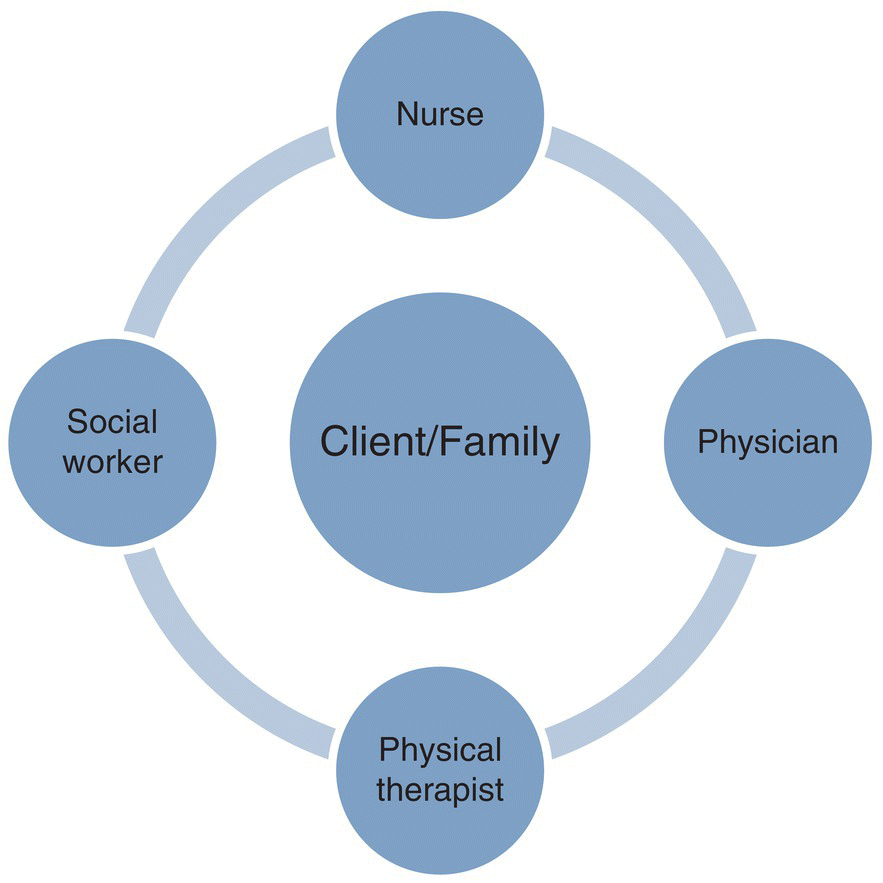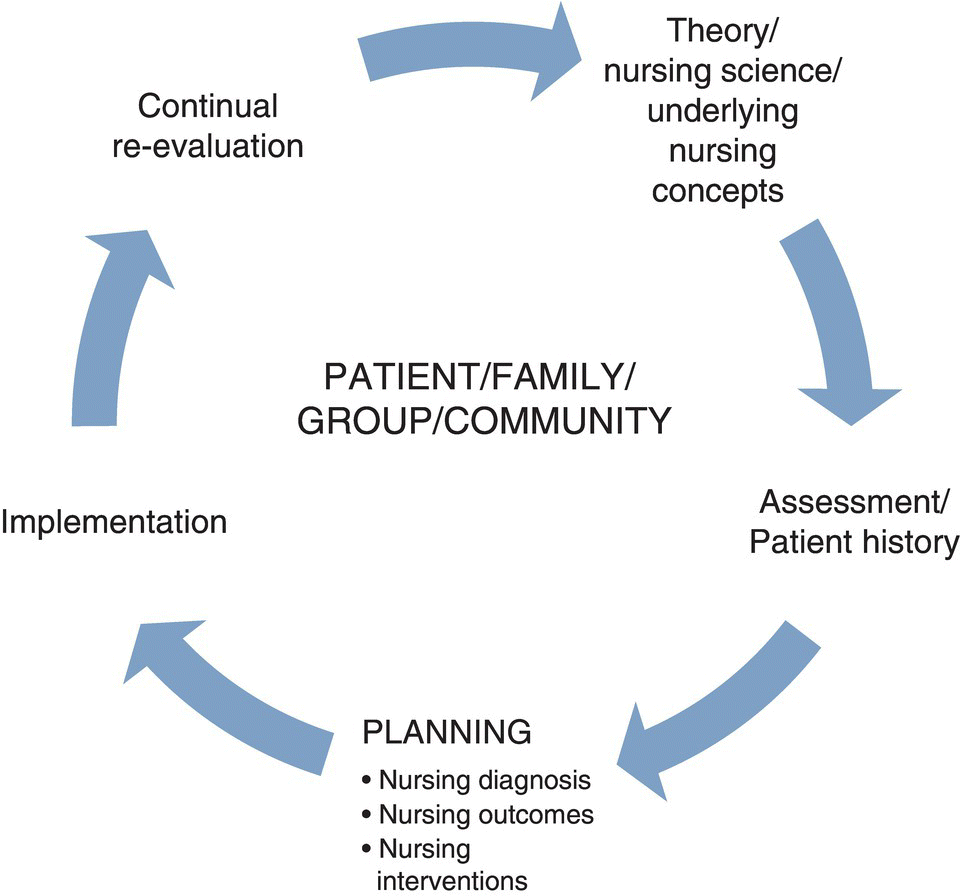Chapter 1 Susan Gallagher-Lepak, RN, PhD Healthcare is delivered by various types of healthcare professionals, including nurses, physicians, and physical therapists, to name just a few. This is true in hospitals as well as other settings across the continuum of care (e.g., clinics, home care, long-term care, churches, prisons). Each healthcare discipline brings its unique body of knowledge to the care of the client. In fact, a unique body of knowledge is often cited as a defining characteristic of a profession. Collaboration, and at times overlap, occurs between professionals in providing care (Figure 1.1). For example, a physician in a hospital setting may write an order for the client to walk twice per day. Physical therapy focuses on core muscles and movements necessary for walking. Nursing has a holistic view of the patient, including balance and muscle strength related to walking, as well as confidence and motivation. Social work may have involvement with insurance coverage for necessary equipment. Figure 1.1 Example of a Collaborative Healthcare Team Each health profession has a way to describe “what” the profession knows and “how” it acts on what it knows. this chapter is primarily focused on the “what.” A profession may have a common language that is used to describe and code its knowledge. Physicians treat disease and use the International Classification of Disease taxonomy, ICD-10, to represent and code the medical problems they treat. Psychologists, psychiatrists, and other mental health professionals treat mental health disorders and use the Diagnostic and Statistical Manual of Mental Disorders, DSM-V. Nurses treat human responses to health problems and/or life processes and use the NANDA International, Inc. (NANDA-I) nursing diagnosis taxonomy. The nursing diagnosis taxonomy, and the process of diagnosing using this taxonomy, will be further described. The NANDA-I taxonomy provides a way to classify and categorize areas of concern to nursing (i.e., foci of the diagnoses). It contains 235 nursing diagnoses grouped into 13 domains and 47 classes. A domain is a “sphere of knowledge; examples of domains in the NANDA-I taxonomy include: Nutrition, Elimination/Exchange, Activity/Rest, or Coping/Stress Tolerance (Merriam-Webster, 2009). Domains are divided into classes (groupings that share common attributes). Nurses deal with responses to health conditions/life responses among individuals, families, groups, and communities. Such responses are the central concern of nursing care and fill the circle ascribed to nursing in Figure 1.1. A nursing diagnosis can be problem-focused, or a state of health promotion or potential risk (Herdman, 2012): Although limited in number in the NANDA-I taxonomy, a syndrome can be present. A syndrome is a clinical judgment concerning a specific cluster of nursing diagnoses that occur together, and are best addressed together and through similar interventions. An example of a syndrome is chronic pain syndrome (00255). Chronic pain is recurrent or persistent pain that has lasted at least three months and that significantly affects daily functioning or well-being. This syndrome is differentiated from chronic pain in that additionally the chronic pain has a significant impact on other human responses and thus includes other diagnoses, such as disturbed sleep pattern (00198), social isolation (00053), fatigue (00093), or impaired physical mobility (00085). The nursing process includes assessment, nursing diagnosis, planning, outcome setting, intervention, and evaluation (Figure 1.2). Nurses use assessment and clinical judgment to formulate hypotheses, or explanations, about presenting actual or potential problems, risks, and/or health promotion opportunities. All of these steps require knowledge of underlying concepts of nursing science before patterns can be identified in clinical data or accurate diagnoses can be made. Figure 1.2 The Modified Nursing Process From T.H. Herdman (2013). Manejo de casos empleando diagnósticos de enfermería de la NANDA Internacional. [Case Management using NANDA International nursing diagnosis] XXX CONGRESO FEMAFEE 2013. Monterrey, Mexico. (Spanish). Knowledge of key concepts, or nursing diagnostic foci, is necessary before beginning an assessment. Examples of critical concepts important to nursing practice include breathing, elimination, thermoregulation, physical comfort, self-care, and skin integrity. Understanding such concepts allows the nurse to identify patterns in the data and diagnose accurately. Key areas to understand with the concept of pain, for example, include manifestations of pain, theories of pain, populations at risk, related pathophysiological concepts (e.g., fatigue, depression), and management of pain. Full understanding of key concepts is needed as well to differentiate diagnoses. For example, in order to understand hypothermia or hyperthermia, a nurse must first understand the core concepts of thermal stability and thermoregulation. In looking at problems that can occur with thermoregulation, the nurse will be faced with the diagnoses of hypothermia (00006) (or risk for), hyperthermia (00007) (or risk for), but also risk for imbalanced body temperature (00005) and ineffective thermoregulation (00008). The nurse may collect a significant amount of data, but without a sufficient understanding of the core concepts of thermal stability and thermoregulation, the data needed for accurate diagnosis may have been omitted and patterns in the assessment data go unrecognized. Assessment involves the collection of subjective and objective information (e.g., vital signs, patient/family interview, physical exam) and review of historical information in the patient chart. Nurses also collect information on strengths (to identify health promotion opportunities) and risks (areas that nurses can prevent or potential problems they can postpone). Assessments can be based on a particular nursing theory such as one developed by Sister Callista Roy, Wanda Horta, or Dorothea Orem, or on a standardized assessment framework such as Marjory Gordon’s Functional Health Patterns. These frameworks provide a way of categorizing large amounts of data into a manageable number of related patterns or categories of data.
Nursing Diagnosis Basics

How Does a Nurse (or Nursing Student) Diagnose?

Understanding Nursing Concepts
Assessment
Stay updated, free articles. Join our Telegram channel

Full access? Get Clinical Tree


